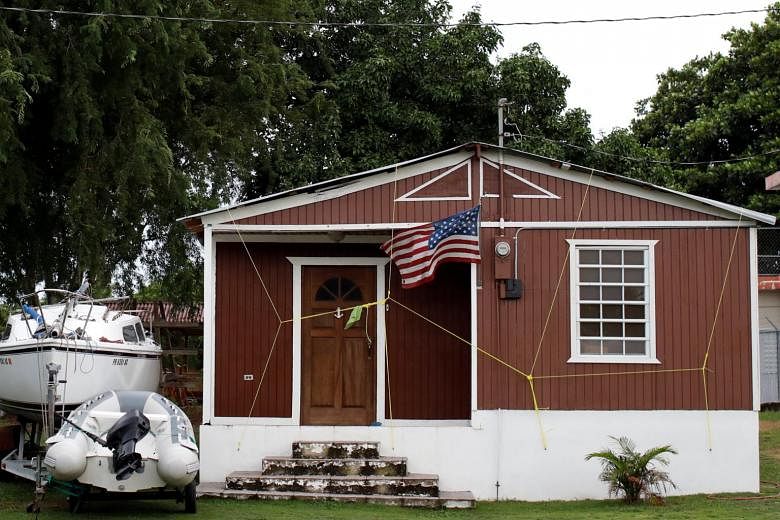SAN JUAN, Puerto Rico (REUTERS) - Hurricane Maria rampaged across Puerto Rico on Wednesday (Sept 20) as the strongest storm to hit the US territory in nearly 90 years, causing major flooding, damaging homes and knocking out power to the whole island after killing at least nine people in the Caribbean.
Maria, the second major hurricane to roar through the Caribbean this month, was carrying winds of up to 250kmh, when it made landfall near Yabucoa, on the south-east of the island of 3.4 million people.
It ripped the roofs off buildings and turned low-lying streets into rushing rivers of debris knocked down by winds.
Its winds downed trees and damaged homes and buildings, including several hospitals, local media reported. News pictures showed whole blocks flooded in the Hato Rey neighbourhood of the capital, San Juan.
Streets in San Juan's old town were left strewn with debris, from broken balconies and downed power lines to air conditioning units, shattered lamp posts, uprooted trees and dead birds.
"When we are able to go outside, we are going to find our island destroyed," Abner Gomez, the director of the island's emergency management agency, known by its Spanish language acronym AEMEAD, was quoted as saying by El Nuevo Dia newspaper.
"It's a system that has destroyed everything in its path."
Maria was producing widespread and dangerous flooding across the island, the National Weather Service said Electricity was believed to be out across the island, said Pedro Cerame, a spokesman for Governor Ricardo Rossello.
Authorities had not yet been able to assess the extent of the damage, he said.
Thousands of people had sought safety in shelters.
"God is with us; we are stronger than any hurricane," Rossello said on Twitter. "Together we will rise again."
By 2pm ET (2am on Thursday, Singapore time), Maria's centre was heading away and it was located just north of the island, the US National Hurricane Centre said. As expected when hurricanes move over hilly or mountainous ground, it had lost strength. But with top winds of 185kmh, it was still a Category 3 on the five-point Saffir-Simpson scale, a major hurricane.
It was forecast to maintain strength as it passed the northeast coast of the Dominican Republic later on Wednesday.
At one point a rare Category 5 storm, Maria killed at least seven people on the island of Dominica, government officials said, and two people in the French territory of Guadeloupe as it barrelled through the Caribbean. It also caused widespread damage on St Croix, one of the US Virgin Islands.
Hurricane Irma, which ranked as one of the most powerful Atlantic storms on record, also left a trail of destruction in several Caribbean islands and Florida this month, killing at least 84 people in the Caribbean and the US mainland.
FRAGILE HOMES
Maria was expected to dump as much as 66cm of rain on parts of Puerto Rico, the NHC said. Storm surges, when hurricanes push ocean water dangerously over normal levels, could be up to 2.7m.
Many homes and businesses across Puerto Rico have wooden or tin roofs, cheaper building materials that also keep homes cooler in the balmy Caribbean climate, but no match for storms of the intensity of Maria.
"This might be a new, permanent part of our lives," said Ramon Claudio Ortiz, 71, a retired lawyer. "We're going to have to revisit our building codes."
The Weather Undergound website said Maria, classified as a Category 4 hurricane when it landed, was the second strongest hurricane ever recorded to hit Puerto Rico, behind only the 1928 San Felipe Segundo hurricane, which killed more than 300 people.
Maria brought its destruction at a time when Puerto Rico is struggling financially, grappling with the largest municipal debt crisis in US history, with both its government and the public utility having filed for bankruptcy protection amid disputes with creditors.
Even though Irma grazed north of Puerto Rico and did not hit the island directly, it knocked out power for 70 per cent of the island, and killed at least three people.
DOMINICA 'IN A DAZE'
Before hitting Puerto Rico, Maria ripped off roofs and downed trees as it passed west of St Croix, home to about half of the US Virgin Islands' 103,000 residents.
Some 65 to 70 per cent of the buildings on St Croix were damaged by the storm, said Holland Redfield, who served six terms in the US Virgin Islands senate.
"There were a lot of homes that had lost their roofs. It was a sad sight," Redfield said in a phone interview, describing viewing the island. "I'm in a very densely populated area now and I see a tremendous amount of confusion. A lot of trees are down."
In Guadeloupe, at least two people were killed, according to France's minister for overseas territories. Many roads were blocked and 40 per cent of the population was without power, the overseas territories ministry said in a statement.
The island of Dominica, with a population of about 73,000, was devastated by Maria earlier in the week. Hartley Henry, principal adviser to Prime Minister Roosevelt Skerrit, said in a Facebook post on Wednesday that "the country is in a daze."
Maria was expected to move near the Turks and Caicos Islands and southeastern Bahamas on Thursday night and Friday, the NHC said. So far, it looked unlikely to threaten the continental United States.

